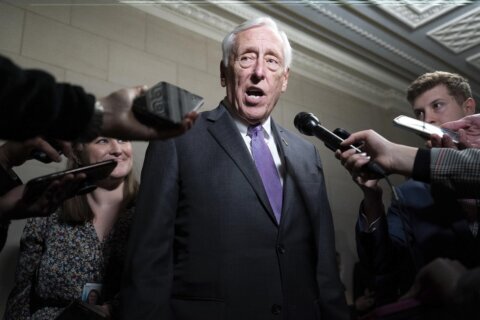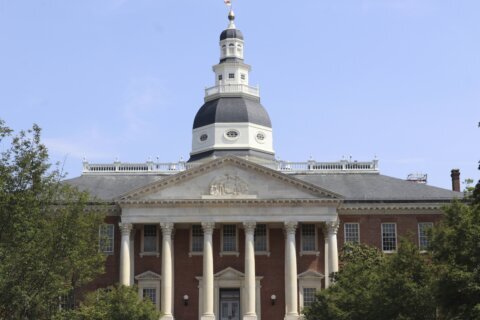This article was republished with permission from WTOP’s news partners at Maryland Matters. Sign up for Maryland Matters’ free email subscription today.
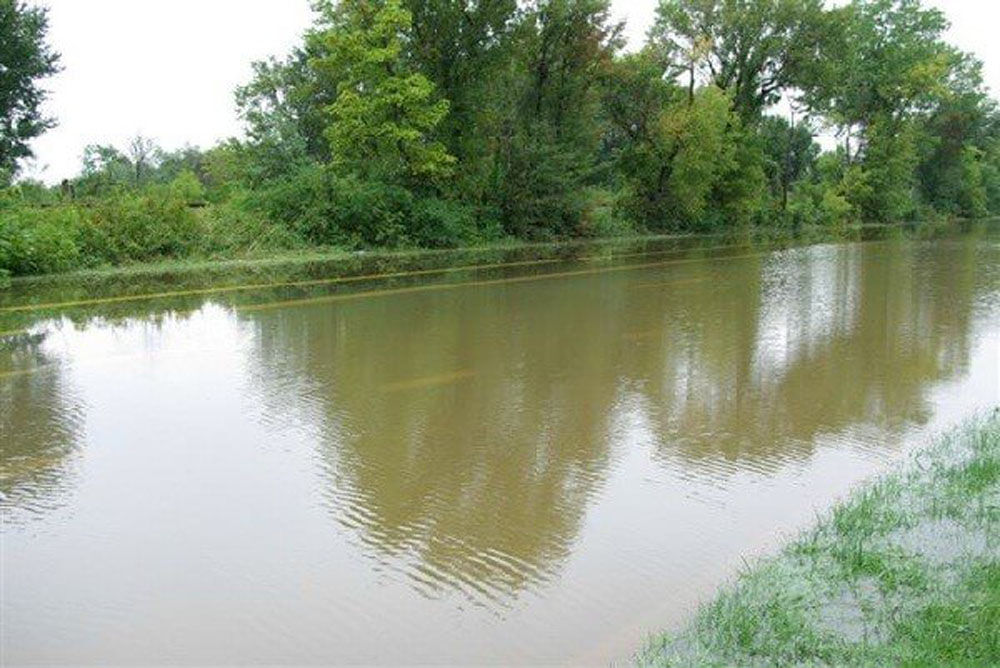
This content was republished with permission from WTOP’s news partners at Maryland Matters. Sign up for Maryland Matters’ free email subscription today.
A new report puts a dollar value on what it means to get stuck on flooded roads in Maryland.
In the first eight months of 2020, the economic cost of motorist and freight delays was nearly $15.1 million, according to the study, in which researchers analyzed the effect of flooding on about 20% of state-maintained roadways, or about 15,000 lane miles.
The report was completed by strategic consulting group ICF, commissioned by The Pew Charitable Trust.
Using State Highway Administration data, researchers analyzed 2,771 flood related incidents from 2006 to 2015 to quantify damage to critical infrastructure, harm to local economies and risks to public safety.
Roadway flooding incidents are estimated to affect over 480,000 people in Maryland annually, they found.
“[It] shows how future flooding can affect roadways and the cumulative impacts to transportation users,” said co-author and ICF’s climate resilience director Angela Wong. “It totaled more than $230 million during the study period [2006 to Aug. 2020].”
This figure does not account for remediation from damage, vehicle repair, emergency services and other costs associated with flooding.
Seventy-eight percent of the flooding incidents studied occurred outside the FEMA 500-year flood plains, geographic areas that would require flood insurance and where construction is more stringently regulated.
That finding confirms what Gerald Galloway, emeritus research professor of Civil and Environmental Engineering at the University of Maryland concluded in The Growing Threat of Urban Flooding: A National Assessment, a report he co-authored in 2018.
Undersized infrastructure, inadequate storm and wastewater management systems and rapid land development all contribute to increases in urban flooding, he said.
It’s an issue that’s best handled locally, as no federal agency is charged with oversight of federal support for urban flooding, Galloway said.
“The most important single thing is to build resilience, or the ability to bounce back when you had this disaster and understand your risk and what you’re willing to do to take care of [it],” he said.
Maryland Matters looked at two highway projects to show how Maryland is building that resilience — not by engineering its way around Mother Nature, but rather by working with her.
Raising US 1 by three feet
A low-lying bend of U.S. 1 near Ammendale Road in Beltsville used to look more like a four-lane river after heavy rains.
The flooding used to close the “critical north-south roadway … several times a year,” said Dana Havlik, a State Highway division chief.
So, in 2014, the State Highway Administration undertook a three-year, $10.6 million project to improve a 30-year-old drainage system along a half-mile stretch next to the Beltsville Motor Vehicle Administration.
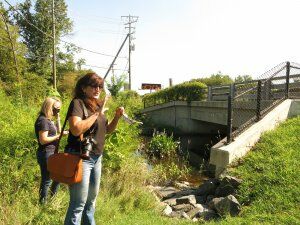
“It was a very expensive project because it involved raising the roadway three feet in this location,” Havlik said.
Other improvements included new storm drains and the replacement of an aging and undersized culvert with a new bridge over Ammendale Branch. This helped to convey the stream flow into a tributary of the Anacostia River, said Sandy Hertz, director of the Office of Climate Change Resilience and Adaptation for the Maryland Department of Transportation.
Earlier this month Hertz visited the site to check out the natural systems under the bridge and along an adjacent road, which are flowering in late summer with native plants and grasses, cattails and newly planted wetland species, which she said like to get their feet wet.
“It’s a good example to demonstrate the different things we can do to improve roadway drainage while also enhancing the surrounding environment,” she said.
And, it appears to be working.
“We haven’t had a closure since the project was completed in 2017,” Havlik said.
Such projects are big undertakings, with a full schedule of interconnected jobs that require approvals from multiple agencies. Adding to the complexity, the work plan must also consider neighboring jurisdictions.
“ … We may be improving this section, but if somebody downstream hasn’t improved theirs and [we’re] connected, then you could still have a backwater of flooding that occurs within our right of way,” Hertz said. “It’s a timestamp, you put something in place, and you’re looking at the land use at that moment. And it changes constantly.”
Complaints (and fears) on I-695
Havlik said a recently completed $12.7 million project on I-695 at Cromwell Bridge Road near Towson is a good example of building resiliency and environmental stewardship.
Crews stabilized the roadway embankment, restored the degraded stream, and reforested its banks and flood plain as a buffer habitat. New roadway drainage structures were added, the sewage line was relocated and a quarter-acre submerged-gravel wetland was constructed to manage stormwater runoff from the highway.
The project was prioritized in 2018 after mounting complaints from neighbors and was completed this summer.
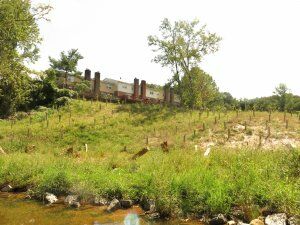
Standing among a newly planted grove of willows and native shrubs that stretches from the Minebank Run stream valley to townhomes at the edge of a steep embankment, Havlik recalled the safety hazard that erosion posed when six outfall pipes were failing.
“Citizens originally raised the issue, that they were losing their property, that it was unsafe for the children to play,” she said.
Now, the ecosystem benefits of the completed project are undeniable.
“It’s a holistic approach to how roadways can be incorporated into an existing environment, and how a roadway drainage project can mitigate some of the [flood] impacts from the site, making the system much more resilient.”
And, she added: “We need to be looking at every project from this perspective. How is it impacting the environment?”
Hertz nodded in agreement. “It’s got to be a systems fix across Maryland,” she said.
Maryland facing challenges ahead
The Fourth National Climate Assessment, a report mandated by Congress, concluded that “heavy downpours are increasing nationally, especially over the last three to five decades … [and that] increases in the frequency and intensity of extreme precipitation events are projected for all U.S. regions.”
Maryland is facing these extremes, from the catastrophic Ellicott City floods in 2016 and 2018 — which spurred creation of an extensive resiliency response plan — to the deluge from Hurricane Ida earlier this month that displaced 150 people from a flooded Rockville apartment complex and left one person dead.
Among conclusions of the 2018 report on the scope and consequences of urban flooding in the United States, co-author Gerald Galloway wrote: “The growing number of extreme rainfall events that produce intense precipitation are resulting in — and will continue to result in — increased urban flooding unless steps are taken to mitigate their impacts.”
Hertz said Maryland is being proactive on these issues.
“Maryland is leading on legislation around resiliency and protection of taxpayer funded projects,” she said.
In 2014, the Maryland legislature established the Coast Smart Council, to determine siting and design criteria to address sea level rise and coastal flooding.
That council then created the Coast Smart Construction Program to determine how those criteria are put into practice for state-funded projects.
Hertz said she is optimistic about the process, as academics and experts in the public and private sectors are all engaged in the effort to mitigate flooding.
“We are trying to find solutions that not only allow us to leverage state and federal funding, but also, to learn from each other about best practices and ways that maybe we can partner and coordinate on emergency response or flood control,” she said.
“And that way we can make better decisions, so that one decision doesn’t negatively impact another,” she said. “We have to be aware that we’re all in this together.”
Rosanne Skirble is a freelance writer in Silver Spring.

